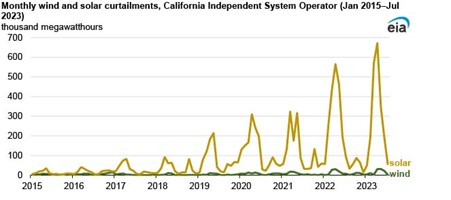News
better business decisions
Posted 2 years ago | 2 minute read

Solar and wind power curtailments are rising in California
The California Independent System Operator (CAISO) is increasingly reducing the generation of electricity from solar and wind sources due to the rapid expansion of these renewable energy sources in the state.
CAISO mandates that solar and wind power generators limit their production during times of congestion, when power lines cannot handle the available energy, or oversupply, when generation surpasses the demand for electricity.
As of October 30, the Energy Information Administration (EIA) noted a significant increase in congestion-related curtailments in CAISO since 2019, primarily because the growth in solar generation has outpaced upgrades in transmission capacity.
In 2022, CAISO curtailed 2.4 million megawatt-hours (MWh) of utility-scale wind and solar output, a 63% increase from the previous year. As of July 2023, more than 2.2 million MWh of wind and solar output have been curtailed, with solar energy accounting for nearly all the curtailed energy – 95% in 2022 and 94% from January to July 2023.
The increase in renewable capacity in California has led CAISO to curtail more renewable generation. In 2014, a total of 9.0 gigawatts (GW) of wind and solar capacity were built in California. By July 2023, this number had escalated to 17.6GW, and an additional 3GW is planned to be added by the end of 2024.

To address the growing curtailment issue, CAISO is exploring various solutions including promoting the development of flexible resources to respond rapidly to fluctuations in demand, such as:
- Expanding battery storage. Currently, California has 4.9 GW of battery storage, with plans for an additional 7.6 GW by the end of 2024. This storage allows renewable generators to store excess electricity that would otherwise have been curtailed.
- Adopting hydrogen production and energy storage, generated through surplus renewable electricity in the spring and stored for use during high-demand periods in the summer, offering long-term storage capabilities.
- Increasing demand response programs, using time-of-use tariffs to shift consumer demand to off-peak hours.
- Incorporating electric vehicle charging systems that can adapt to changes in grid conditions.






